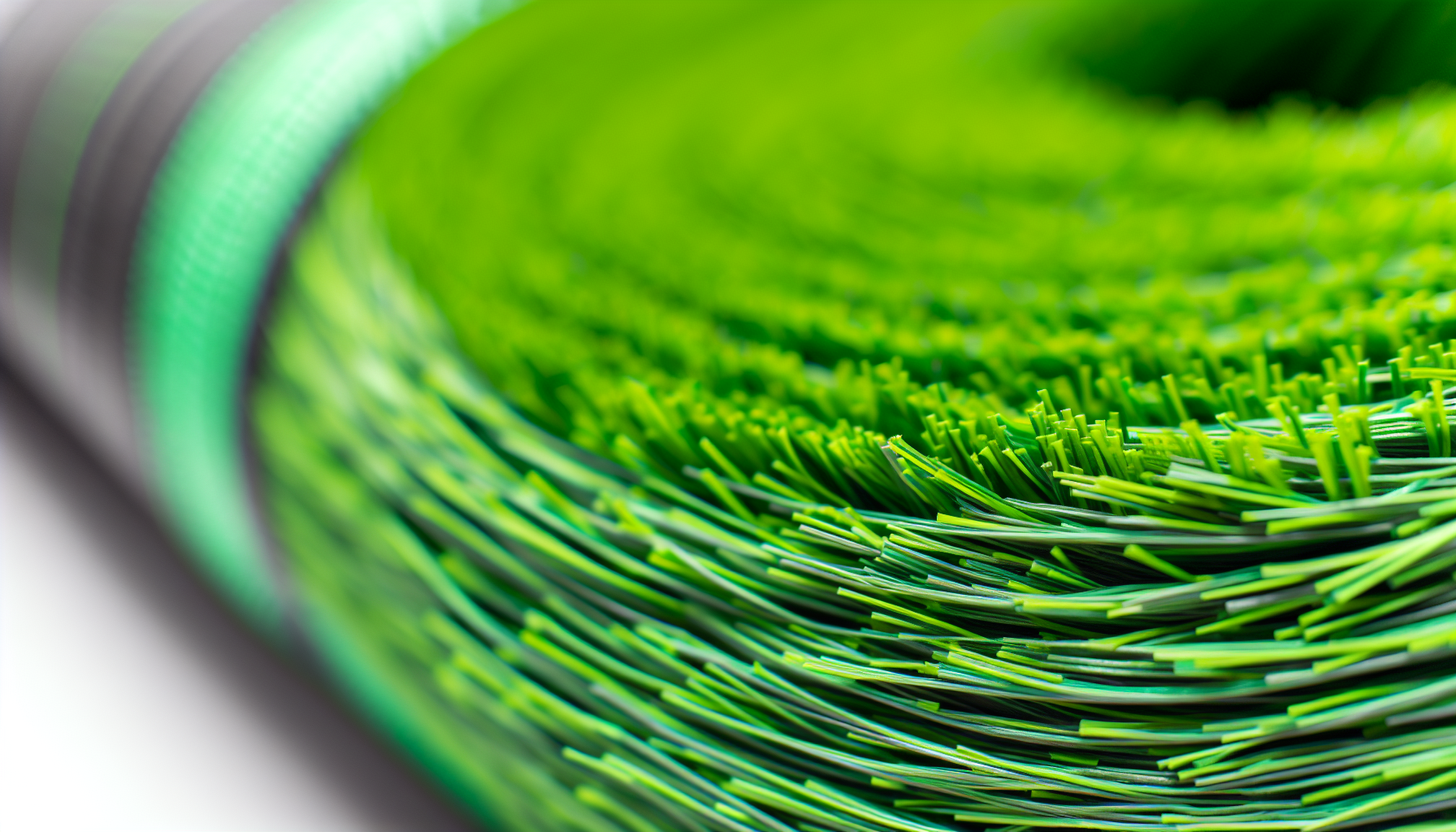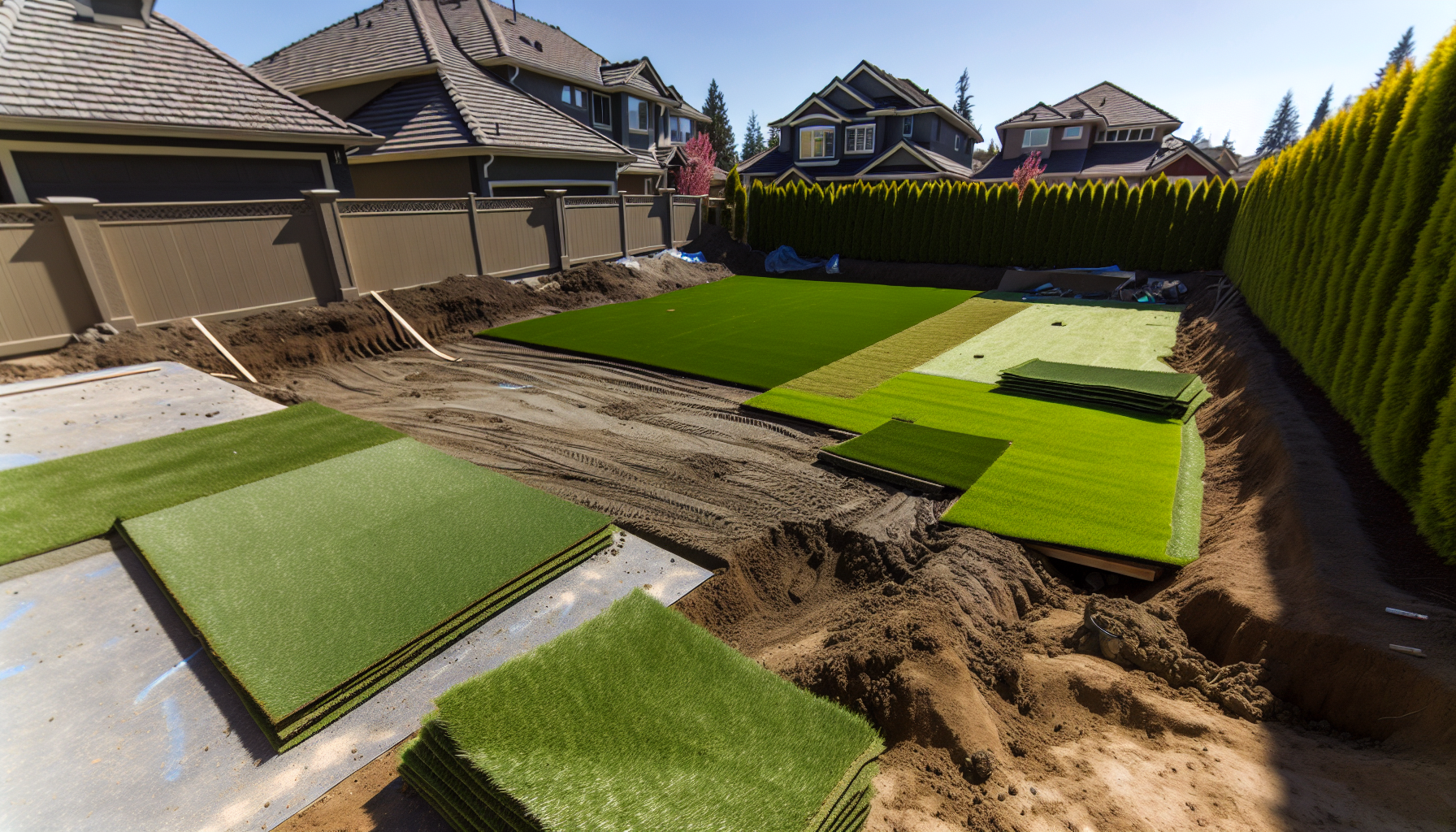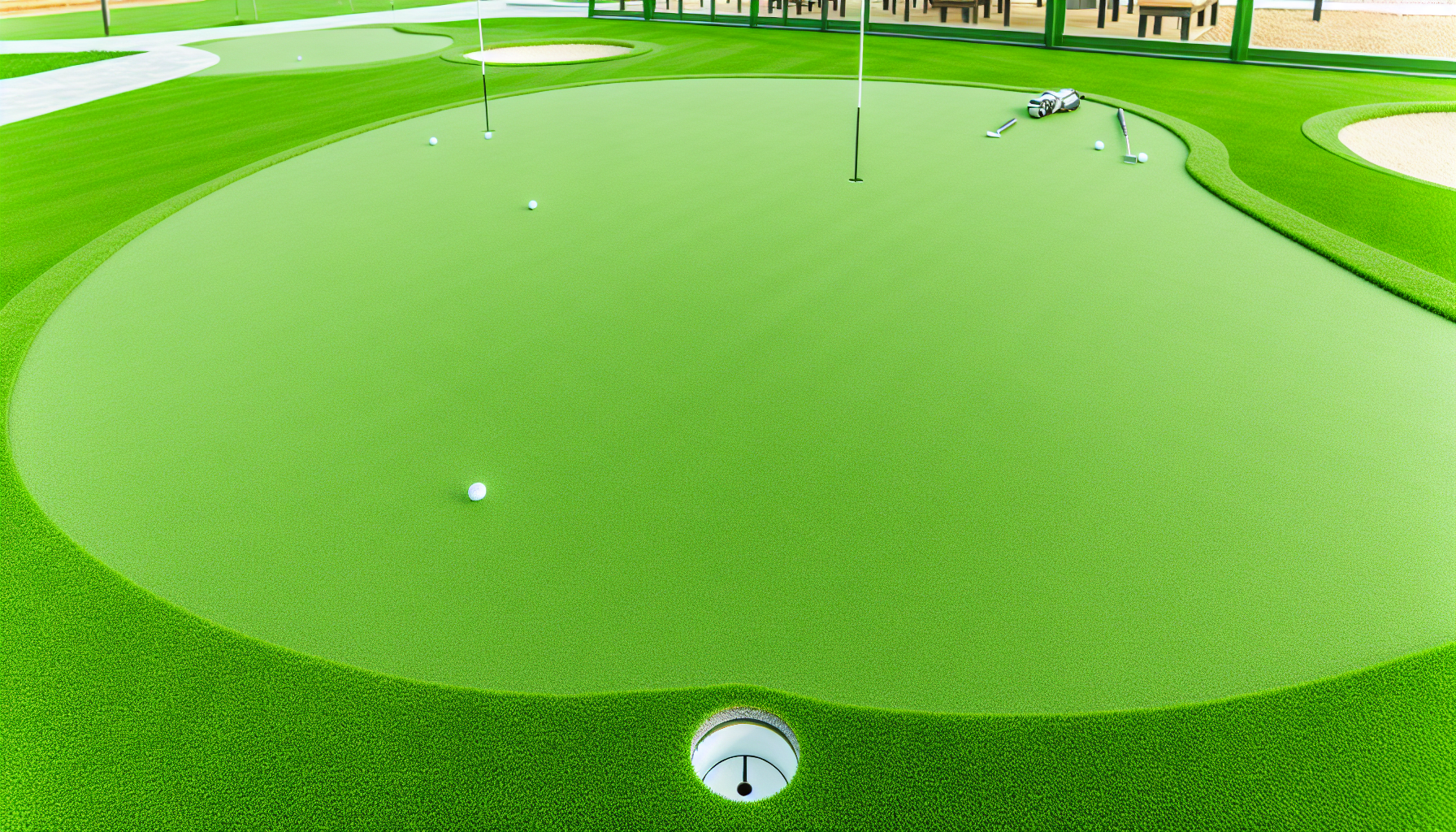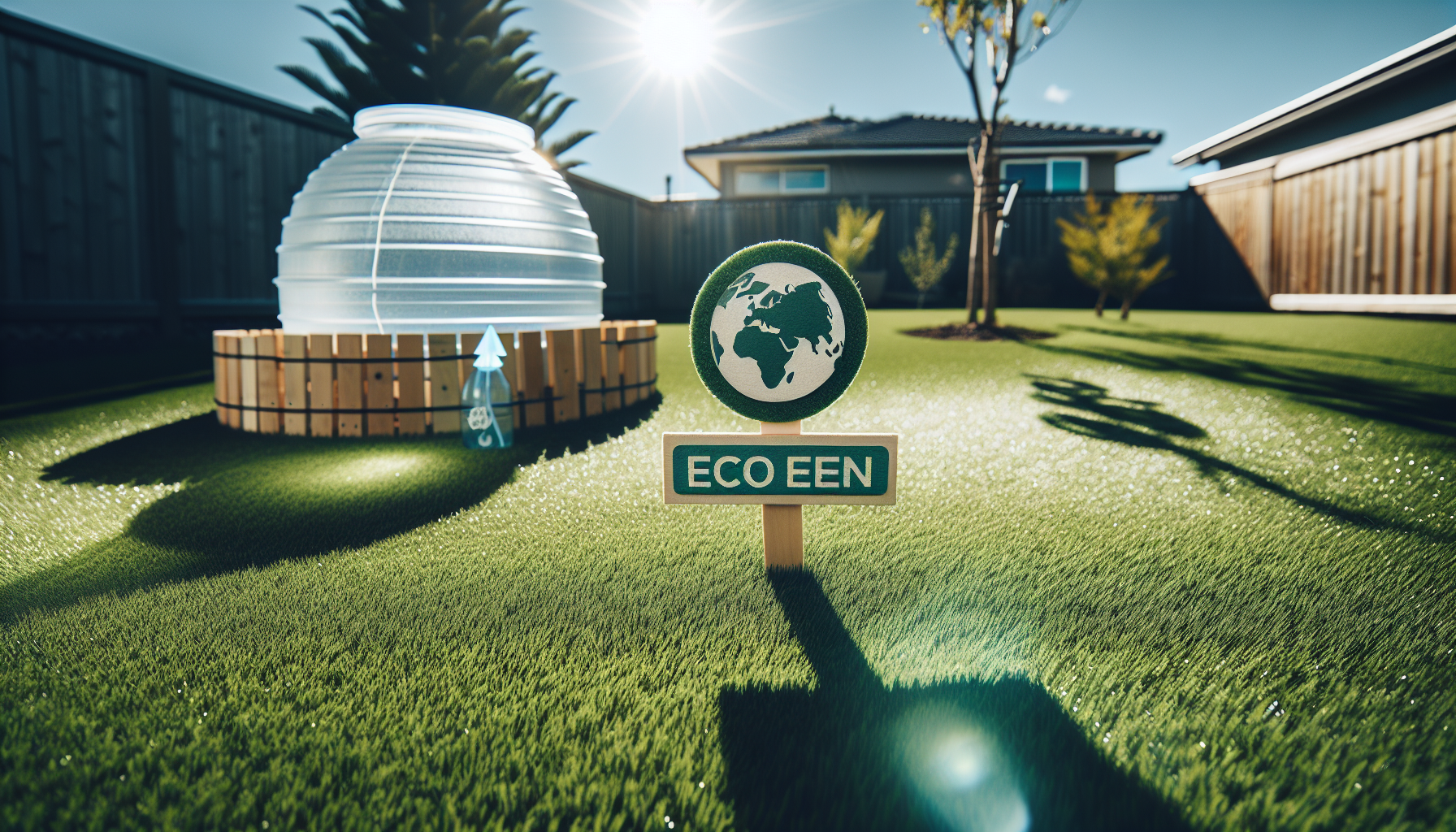Artificial Turf Sales & Installation Services in Las Vegas, NV

Top Quality Artificial Turf: The Ultimate Guide for Your Green Space
Are you contemplating the shift to artificial turf? This guide cuts through to the essentials, exploring the longevity, maintenance ease, and cost benefits of artificial turf. With its capacity to withstand diverse weather conditions and heavy use, artificial turf often becomes the practical choice for an impeccable and enduring green space. Delve into the fine distinction of selecting, installing, and caring for artificial turf, and learn about its environmental perks without the sales pitch.
Key Takeaways
Modern artificial turf features advanced design with durable synthetic fibers and UV inhibitors for longevity, with a variety of types available to closely mimic the look and feel of natural grass.
Artificial turf offers significant long-term cost savings and eco-friendly benefits over natural grass due to its minimal maintenance, water conservation, and avoidance of fertilizers and pesticides.
Technological advancements in artificial turf include innovations such as Hydroflow™ drainage technology, Its V and Z-shaped blades, white backing, and added folds ensure durability and comfort. Hybrid surfaces for sports applications, and pet-friendly turf options with anti-microbial properties.
Exploring the World of Artificial Turf

Synthetic turf, a man-made surface that imitates real grass using artificial fibers, has come a long way since its inception. Today’s synthetic turf is no longer just a plain green carpet, but closely resembles natural grass in both texture and appearance thanks to advances in technology and design. It consists of woven strands held together by backing material such as perforated felt, latex, polyester or polyethylene.
The blades used in artificial grass are typically made from strong materials like nylon,polypropylene or polyethylene fibers which can withstand heavy foot traffic and extreme weather conditions. To ensure longevity, UV inhibitors are incorporated into the resin to prevent fading and deterioration over time. The meticulous construction process results in an enduring option for those seeking low-maintenance alternatives to natural grass thus making it increasingly popular for various applications.
A durable alternative to real grass, synthetic turf – has evolved significantly over the years with advancements such as incorporation of UV inhibitors within their fiber structure ensuring they retain their “green” look without deteriorating while at the same time reducing maintenance requirements, making them highly sought after especially when considering factors like cost-effectiveness,humidity levels around target application area, and aesthetic appeal. feel free to view our product specs.
The Anatomy of Synthetic Grass
Synthetic grass is available in various styles, each with its own shade, texture and blade length to imitate the natural appearance of real grass. To create a realistic look, artificial lawns use a thatch layer made up of yarn or fibers containing additional strands resembling those found in natural grass. This layer also incorporates brown-colored fibers which simulate the dying process of live grass for an even more authentic effect.
The caliber of fake lawn can be determined by two factors: density and pile height. A higher stitch count indicates better quality as it means there are more blades per square inch on the turf surface. Pile heights vary based on preference and usage – shorter ones being best suited for high-traffic areas while longer lengths give off a luxurious vibe.
Maintenance needs as well as drainage efficiency depend largely on what kind of backing system is used for synthetic surfaces. Different types catered towards specific applications may alter these aspects accordingly. A strong backing structure usually consists of at least primary and secondary layers designed to securely hold onto individual blades, especially important when dealing with busy locations.
Advantages of Choosing Synthetic Over Natural Grass
The minimal maintenance requirement of synthetic turf is one of its main advantages over natural grass, resulting in cost savings for tools, supplies and labor. To natural grass, which may need frequent interventions and replacements, artificial turf can last up to 25 years making it a more financially efficient option in the long run.
There are various benefits that come with using artificial grass instead of natural grass.
It has a high durability level allowing it to withstand heavy usage and extreme weather conditions thereby reducing repair or replacement costs.
Synthetic grass maintains its appearance regardless of climate providing an even playing surface unaffected by weather changes.
After rain or moisture exposure, it dries quickly preventing delays commonly associated with maintaining traditional lawns affected by mud.
Installation Insights: Transforming Your Space with Artificial Turf

The process of enhancing your area with synthetic grass involves multiple essential steps. To start, the base must be prepared by leveling and compacting permeable aggregates such as CMB or DG to guarantee effective drainage and ground stability. Next, tools like galvanized turf nails, seam tape, and turf glue are used to secure the turf in place.
When it comes to installation techniques for artificial turf on different surfaces (such as soil, wood or concrete), there can be some variation. It is crucial to choose a suitable type of artificial grass based on an analysis of the intended use for the space (including expected foot traffic and weather conditions) in order to ensure its durability over time. For example, football fields often utilize a polyethylene-blend fiber tufted into a polypropylene backing for added strength. Additionally, the choice of backing material also plays an important role in promoting proper water drainage from the surface above it.
Residential Installation Tips
Selecting the appropriate type of turf is crucial for residential artificial turf installation. For households, polyethylene-based turfs offer a perfect balance between strength and natural appearance, making them ideal for frequently used areas or homes with pets. The process includes preparing a four-inch compacted base layer made of road base rock and ensuring proper drainage by maintaining minimal slope before securing the cut and stretched turf in place.
Although opting to install the turf yourself can save money, hiring professionals guarantees better fitting results as well as efficient water runoff systems that prevent unpleasant odors caused by pet urine. By using synthetic grass, homeowners eliminate tasks like mowing or trimming while avoiding issues such as dealing with mud or harmful chemicals – creating low-maintenance green spaces instead.
Commercial Surfacing Solutions
When it comes to commercial applications of artificial grass, proper training and certification are crucial for achieving exceptional results. It is important to consider certifications offered by artificial grass manufacturers and the artificial grass Council as they ensure that installers have the necessary knowledge and skills. When covering large areas with artificial turf, all blades should face in the same direction for optimal appearance.
Applying infill correctly is another key factor in maintaining both aesthetics and functionality of commercial artificial grass installations. By following these guidelines, businesses can ensure a successful installation process.
Businesses may choose between investing in specialized equipment or opting for self-installation using cost-effective used artificial grass products. For example, SYNLawn. Tee Strike offers durable solutions specifically designed for use on commercial tee-lines with precise installation services provided by certified professionals ensuring top performance at lower costs compared to buying new materials outright.
Athletic Fields and Play Areas: A Safe and Durable Choice
Athletic fields and play areas are increasingly turning to artificial turf for its durability and safety benefits in athletic competition. Construction advancements have significantly reduced the risk of injuries such as ACL tears, concussions, and ankle sprains on these surfaces, providing safer conditions for athletes. Modern artificial grass is optimized for grip and shock absorption through improved coefficients of friction and restitution levels.
The long-term resiliency of artificial turf allows it to withstand heavy foot traffic without significant wear or changes in surface consistency over time. Regular maintenance checks should be conducted to inspect seams, damage to inlays, and manage moisture content with monthly grooming sessions crucial for preserving a top-notch playing field.
To ensure player safety remains uncompromised, turf fields should undergo annual impact testing (g-max) to assess their ability to absorb shock during gameplay.This helps identify any potential hazards that may arise from damaged or worn out sections, to promptly address them before they can cause harm.
Synthetic Turf for Competitive Edge
Advanced technologies in artificial turf have become crucial for gaining a competitive edge in sports. For instance, Super YarnTM incorporates DualChillTM IR. Reflective technology that reflects infrared light to lower the surface temperature of the field. This creates a cooler playing environment and benefits athletes during gameplay.
The use of synthetic turf has revolutionized how various sports are played by enhancing playability and increasing game speed. Artificial grass products like K9Grass Sport can be customized to provide different levels of traction, making it suitable for diverse sporting activities such as cricket, hockey, rugby, baseball, soccer, tennis, lacrosse, and fitness training.
Advanced features such as antistatic and antimicrobial properties incorporated into turfs like SYNLawn SpeedTurf and TrackTurf make them ideal options for athletic fields. These specialized surfaces also cater specifically to speed and agility training needs on top of being suitable for traditional team sports mentioned above.
Creating Fun and Secure Playgrounds
Artificial grass is a great choice for playgrounds as it provides both fun and safety for children. This type of artificial grass is non-toxic and hypoallergenic, making it safe even for kids with allergies. Most artificial turfs used in playgrounds come with padding layers that offer critical fall height protection to minimize the risk of injuries from falls.
When considering using artificial grass on playgrounds, there are various benefits to keep in mind.
The fibers used are softer and more resilient compared to natural grass, providing better cushioning during playtime.
With shorter pile heights designed specifically for high traffic areas like playgrounds, this type of turf can withstand heavy use without becoming matted or flattened over time.
Some products such as Super Yarn™ also include StatBlock™ Anti-Static additive which prevents static electricity buildup on the surface – promoting a safer and more comfortable playing experience overall.
The Aesthetics and Functionality of Artificial Putting Greens

Artificial putting greens provide golf enthusiasts with a low-maintenance, weather-resistant practice area that is both visually appealing and functional. These customizable green options cater to individual preferences, including the choice of custom-designed or pre-designed Pro-Series greens, do-it-yourself kits, and portable mats for added convenience.
The quality performance of artificial putting greens depends on several factors such as materials used during installation techniques. To enhance its density structure and complement non-permeable backings, specialized infill material can be utilized. Fixing shorter nails or U-staples ensures proper turf fixation which keeps the surface flat for optimal ball roll.
To their use in creating perfect putting surfaces, synthetic turfs are also widely employed in driving ranges and tee boxes by top companies like SYNLawn who offer high-quality installations for amateur as well as professional golfers alike. Their expertly designed fake grass provides an ideal alternative to natural landscapes without compromising on durability or aesthetics.
Artificial Turf Maintenance 101
Despite artificial turf demanding far less care than natural grass, consistent maintenance remains necessary for preserving its visual charm and extending its durability. Here are some simple tasks you can do to maintain your artificial turf.
Remove solid waste like leaves and pet droppings to prevent discoloration and erosion of grass blades.
For spills and odors, use enzymatic cleaners to break down waste.
Use a mixture of water and vinegar or baking soda to neutralize and remove odors.
By following these maintenance tasks, you can keep your artificial turf looking great for years to come.
Regular maintenance tips for artificial turf include:
Rinsing with water, especially in the absence of frequent rainfall, to clean the turf while preserving infill and drainage properties
Consistently removing large debris and solid pet waste from the surface
Using non-metallic rakes or brooms for brushing and debris removal to prevent damage to the turf fibers.
Eco-Friendly Aspects of Synthetic Lawns

Artificial grass is not only a convenient option for landscaping, but it also provides numerous benefits to the environment. The most significant advantage is water conservation in hot and dry areas as synthetic lawns do not require watering. This makes them an excellent choice for xeriscaping and can lead to savings on water bills.
The use of artificial turf has positive effects on the ecosystem by reducing pollution from fertilizers, pesticides, and herbicides while improving air quality. They prevent contamination of water sources through runoff during heavy rains or irrigation systems. Another environmental benefit is that there are no grass clippings generated with fake turf leading to reduced waste production.
Advancements in non-fill artificial turf products have made them more environmentally friendly as they closely resemble natural grass without any issues related to infill splashes or microplastics.They play a role in decreasing carbon emissions during transportation due to their lightweight nature.These types of turfs also require less maintenance compared to traditional ones.Finally, the end-of-life recycling process becomes easier, making these newer versions even more sustainable choices.
Innovations in Artificial Turf Technology
In the fast-evolving world of artificial turf, constant innovations and advancements are revolutionizing its use. Varying fiber heights and widths have been introduced to simulate the mechanical properties of well-maintained natural grass more closely. Hybrid surfaces provide a safer and versatile option for different sporting events while cooling technology reduces heat absorption.
Modern materials like polyethylene, polypropylene or nylon offer strength, UV resistance as well as visual appeal in varied degrees. As such, modern artificial turf is highly sought-after for uses ranging from sports fields to playgrounds to commercial spaces to residential lawns.
A noteworthy development are non-fill turf systems that rely on dense thatch layers mimicking real grass, improving user experiences significantly. Firms such as TenCate Grass boast advanced options when it comes to this type of system integration into their offerings. Another interesting advancement was integrating optical fibers with these turfs specifically designed for event displays- adding another layer of technological sophistication field-use possibilities.
Super Yarn™ Technology and Other Breakthroughs
The introduction of Super YarnTM technology has made significant strides in the artificial turf industry. This impressive innovation incorporates features such as Sanitized® Antimicrobial, DualChillTM IR Reflective and StatBlockTM Anti-Static to enhance the performance of synthetic grass. Renewable materials like sugar cane are being utilized to produce environmentally sustainable turf products that may receive USDA certification for reduced environmental impact.
A major advancement in this field is the shock pad technology, which utilizes molded polypropylene panels for improved shock absorption and consistent firmness across all types of artificial grass surfaces. Pet-friendly options have also been developed with K9Grass Elite and K9Grass Classic+ offering exceptional waste management capabilities along with substantial warranties for customer peace-of-mind when choosing a product suitable to their needs.
To make an informed decision on which type of synthetic grass best fits your requirements, it’s important to carefully review each product’s specifications before making a choice.
Artificial Turf for Pets: Hygienic and Hassle-Free Solutions
Pet owners can benefit from the convenience and cleanliness of using artificial turf. This type of grass utilizes flow-through backing, like MaxxFlow products, to effectively drain liquid waste and prevent odors or damage. With added antimicrobial infill, artificial grass creates a hygienic playing area for pets by actively combating the spread of germs.
By incorporating Sanitized® Antimicrobial technology into their Super YarnTM product line, manufacturers ensure that frequent pet use does not lead to bacterial growth on the turf surface. There are also specialized solutions available such as Got Pee Odor Eliminator which contains live bacteria safe for dogs and designed specifically for use on artificial turf.
One major advantage of synthetic turfs is their natural resistance to pests and insects compared to traditional lawns. Not only does this protect pet health, but it also eliminates any associated costs with pest control measures often needed when dealing with real grass.
The Financial Aspect: Cost-Benefit Analysis of Artificial Turf
Although the initial expense for installing artificial turf can vary from $2 to $25 per square foot, depending on factors like type of grass, area size and specific needs, it offers significant long-term savings. Homeowners can save money by:
Eliminating the need for watering
Skipping seed planting
Not needing pesticides
-Less labor costs if they choose a DIY installation.
These monetary benefits make synthetic grass a cost-effective choice in the future.
Premium fake lawn has an average lifespan of 20 to 25 years, which highlights its overall economic advantage over time. With little maintenance required and high durability levels offered by artificial turf options, any extra investment upfront is offset by reduced expenses such as utility bills and upkeep costs.
Design Possibilities with Synthetic Turf
Synthetic turf presents endless design possibilities for homeowners and landscape designers, adding a modern touch to gardens while minimizing maintenance. By incorporating artificial grass with various materials and shapes, unique garden experiences can be created. Grid pavers are often combined with synthetic grass as an inexpensive solution for pathways or patios. Lava rock and curbing can also be incorporated into low-maintenance designs that require no watering.
The use of artificial grass opens doors to imaginative designs such as rooftop terraces or balcony gardens in urban settings where access is granted by obtaining permission. Backyards can also benefit from the practicality of artificial grass, requiring less upkeep but providing more opportunities for enjoyment through inviting outdoor spaces.
Artificial turf not only revolutionizes traditional landscaping methods, but it offers cost-effective alternatives too, enhancing aesthetics without compromising functionality. With its ability to transform neglected areas into tranquil escapes within any budget range, it is an ideal choice in today’s world.
Global Reach: Where Artificial Turf is Making an Impact
Artificial turf is gaining popularity not just in the US, but around the world, with a projected market value of $7 billion by 2025. Its growth can be seen particularly in Asia Pacific, as evidenced by increased foreign direct investments in countries like China and India. The United States has also embraced artificial turf with over 8,000 fields installed and its use extending beyond sports to include residential landscaping and decorative purposes.
In Europe, there is strong demand for artificial turf primarily from contact sports teams as well as for landscaping needs. This can be seen through major installations such as Moscow’s Luzhniki Stadium and discussions within English football leagues regarding its economic benefits. These global developments demonstrate how artificial turf continues to expand globally across different regions and applications.
Navigating the Market: How to Choose the Right Artificial Turf
Selecting the appropriate artificial turf requires careful evaluation of several factors. It is important to thoroughly examine the quality by considering: visible imperfections, UV protection, consistency, dimensional stability, blade shape and color options. Evaluating for antimicrobial properties can also be beneficial.
The face weight of the grass plays a crucial role in its overall quality and durability as it indicates how much material has been used per square yard. Requesting free samples from suppliers allows you to personally assess different types of turf in terms of appearance and texture. When planning for installation, keep in mind the necessary roll width and length needed to minimize waste and ensure accurate placement on your property.
To achieve desired results with your artificial grass project without exceeding budgetary constraints, calculate all costs associated including materials, removal fees for old vegetation (if applicable), sub-base preparation expenses,infill costs, and any additional drainage requirements that may arise.
It’s essential to choose an experienced installer who provides positive reviews along with comprehensive information about their products installed Finally,take into account all aspects involved when creating a complete budget such as base items like infill ensuring accuracy after factoring supply rates, salary/wages etc.
Summary
Artificial turf is changing the way we view landscaping, from residential lawns to athletic fields and commercial spaces. It offers more than just visual appeal and easy maintenance. It also brings significant economic and environmental benefits. As technology advances, so does the quality, appearance, and functionality of artificial turf – making it a popular choice globally. Whether for homeowners looking to enhance their gardens or businesses seeking cost-efficient solutions or athletes in need of reliable playing surfaces with high performance levels – artificial turf provides a flexible solution that can fulfill these needs seamlessly.
synthetic grass Frequently Asked Questions
Is laying artificial grass less expensive than natural turf?
The initial setup for artificial grass typically incurs a higher cost compared to laying natural turf, which means that natural soil and grass present a more budget-friendly option at the outset. However, over time, artificial turf proves to be a more cost-efficient solution as it requires minimal maintenance and eliminates the need for constant watering and mowing.
What are the environmental benefits of using artificial grass?
Artificial turf does not require any water or harmful chemicals such as pesticides or fertilizers for upkeep. This means that it significantly reduces water usage and chemical pollution, making it an environmentally friendly choice. Additionally, since it does not need to be mowed, there is no carbon emissions from lawn mowers – further contributing to a cleaner environment.
Is artificial turf safe for children and pets?
Yes, artificial turf is completely safe for children, animals, and pets. It is made from non-toxic materials that do not pose any harm if accidentally ingested. Additionally
Can you put artificial turf directly on residential lawns?
Installing artificial turf directly on residential lawns is not advisable. Before laying down the turf, it is crucial to remove any natural grass and organic matter from the soil and create a suitable base for installation. Simply placing artificial turf on bare earth without proper preparation will not yield satisfactory results.
What is the difference between artificial turf and artificial grass?
Artificial grass is made up of shorter fibers and can contain either rubber infill, sand infill, or a combination of both. It is specifically crafted to have a better appearance, texture and performance compared to natural grass. The purpose behind the design is for it to closely mimic the look and feel of real turf while providing an enhanced playing experience.
How much is 500 square feet of artificial turf?
The price for 500 square feet of fake grass can vary between $2,970 to $7,100 and may start at $6,000 or more for bigger projects. This cost includes both materials and labor expenses.
What materials are used in artificial turf?
The composition of artificial turf consists of man-made yarn fibers that are intertwined through a backing material. These fibers, often constructed from nylon, polypropylene, or polyethylene materials, form the blades on the surface of the turf while perforated felt, latex polyester or polyethylene make up the backing layer underneath.
